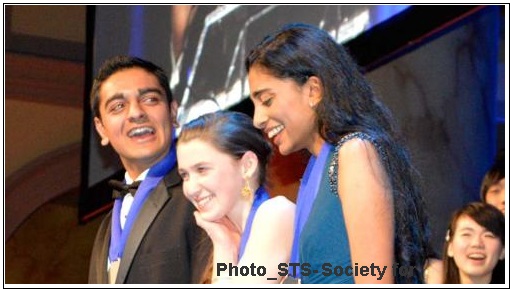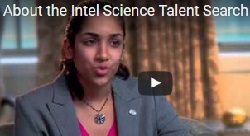NRI Students win Intel Science Talent Search's $150,000 top prize each, in nation's most prestigious science competition
Top Winners' Projects Enhance Medications for Cancer and Heart Disease, Combat Water Pollution and Enable Lung Disease Diagnosis via Smartphone
Innovative Teen Scientists Win more than $1 Million in Awards in Intel Science Talent Search 2016.
Los Angeles, March 15, 2016
NRIpress.club/Ramesh/Gary Singh

NRI Maya Varma (Right), a senior at Presentation High, San Jose, NRI Amol Punjabi (left) of Marlborough, Mass., with fellow first-place winner Paige Brown of Bangor, Maine, were the two of three first-place winners Tuesday night at the Intel Science Talent Search, a national contest sometimes called the Junior Nobel Prizes. Each first-place winner student wins Intel Science Talent Search's $150,000 top prize.
First Place: Three first-place winners received awards of $150,000:
- Smartphone-based lung function analyzer that diagnoses lung disease:
- Maya Varma of Cupertino, California ,demonstrate the problem-solving aptitude of an engineer through innovative design and creativity.
- Varma used $35 worth of hobbyist electronics and free computer-aided design tools to create a low-cost, smartphone-based lung function analyzer that diagnoses lung disease as accurately as expensive devices currently used in medical laboratories. She is proficient in five programming languages, holds leadership roles in multiple honor societies and science and math clubs, and has won grand prizes in several prestigious science competitions
2. Developed software that could help drug makers develop new therapies for cancer and heart disease:
- Amol Punjabi of Marlborough, Massachusetts demonstrate exceptional scientific potential through depth of research and analysis.
- Punjabi developed software that could help drug makers develop new therapies for cancer and heart disease. He is the lead author of a paper on nanoparticles published in ACS Nano and co-author of a paper on a related topic in Nanoscale. Punjabi is also the lead pianist for his high school’s jazz workshop and captain of the Science Olympiad team.
3. Developed a cost-effective filter largely made of calcium alginate strands to remove the phosphate from stormwater systems:
- Paige Brown of Bangor, Maine, demonstrate great scientific potential through their passion to make a difference. Brown studied the water quality of six environmentally impaired local streams with high E. coli levels and five with high phosphate contamination levels.
- She is currently developing a cost-effective filter largely made of calcium alginate strands to remove the phosphate from stormwater systems. Brown is co-captain of the math team and secretary of the Key Club at her high school, and she also helps organize fundraisers for her school and community.
Second Place----- Three second-place winners received awards of $75,000
1. Meena Jagadeesan of Naperville, Illinois, investigated an object in algebraic combinatorics, or the mathematics of counting, to reveal a novel relationship between classes of graphs.
2. Michael Zhang of Berwyn, Pennsylvania, engineered tiny virus-like particles to deliver gene-modifying proteins to target cells for medical therapy by altering the genome of those cells in a controlled way.
3. Milind Jagota of Bethlehem, Pennsylvania, studied the performance of random nanowire networks as a less costly alternative to the transparent conductors now used in touchscreen devices.
Third Place------ Three third-place winners received awards of $35,000.
1. Kunal Shroff of Great Falls, Virginia, discovered new relationships between the key protein associated with Huntington’s disease and the biological processes of cellular death’
2. Nathan Charles Marshall of Boise, Idaho, present day climate change, concluding that Earth can recover from current climate change trends if action is taken soon.
3. Kavya Ravichandran of Westlake, Ohio, use of nanomedicine to destroy potentially fatal blood clots that can cause heart attacks and strokes.
In 2016 Awards, about 1,750 high school seniors entered the Intel Science Talent Search , 300 were announced as semifinalists in January. Of those, 40 were chosen as finalists and invited to Washington, D.C., to compete for the top nine awards.
Intel has more than 100,000 employees, an American multinational technology company headquartered in Santa Clara, California. Intel is one of the world's largest and highest valued semiconductor chip makers
Society for Science & the Public, the nonprofit organization dedicated to public engagement in scientific research and education, has owned and administered the Science Talent Search since its inception in 1942
The Intel Science Talent Search (Intel STS) is the nation's most prestigious science research competition for high school seniors. Since 1942, first in partnership with Westinghouse and beginning in 1998 with Intel, SSP has provided a national stage for the country's best and brightest young scientists to present
Click VIDEO:  Click here Click here

|